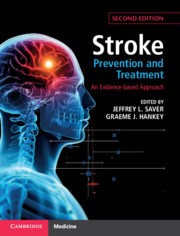Book contents
- Stroke Prevention and Treatment
- Stroke Prevention and Treatment
- Copyright page
- Dedication
- Contents
- Contributors
- Preface
- Part I Foundations
- Part II Systems of Care
- Part III Acute Treatment of Ischaemic Stroke and Transient Ischaemic Attack
- Part IV Acute Treatment of Haemorrhagic Stroke
- Part V Prevention
- Chapter 15 Prevention of Stroke by Lowering Blood Pressure
- Chapter 16 Prevention of Stroke by Lowering Blood Cholesterol Concentrations
- Chapter 17 Prevention of Stroke by Modification of Additional Vascular and Lifestyle Risk Factors
- Chapter 18 Drugs, Devices, and Procedural Therapies to Prevent Recurrent Cardiogenic Embolic Stroke
- Chapter 19 Long-term Antithrombotic Therapy for Large and Small Artery Occlusive Disease
- Chapter 20 Carotid and Vertebral Artery Revascularization
- Chapter 21 Cervical Artery Dissection and Cerebral Vasculitis
- Chapter 22 Prevention of Intracerebral and Subarachnoid Haemorrhage
- Part VI Stroke Rehabilitation and Recovery
- Index
- References
Chapter 20 - Carotid and Vertebral Artery Revascularization
from Part V - Prevention
Published online by Cambridge University Press: 15 December 2020
- Stroke Prevention and Treatment
- Stroke Prevention and Treatment
- Copyright page
- Dedication
- Contents
- Contributors
- Preface
- Part I Foundations
- Part II Systems of Care
- Part III Acute Treatment of Ischaemic Stroke and Transient Ischaemic Attack
- Part IV Acute Treatment of Haemorrhagic Stroke
- Part V Prevention
- Chapter 15 Prevention of Stroke by Lowering Blood Pressure
- Chapter 16 Prevention of Stroke by Lowering Blood Cholesterol Concentrations
- Chapter 17 Prevention of Stroke by Modification of Additional Vascular and Lifestyle Risk Factors
- Chapter 18 Drugs, Devices, and Procedural Therapies to Prevent Recurrent Cardiogenic Embolic Stroke
- Chapter 19 Long-term Antithrombotic Therapy for Large and Small Artery Occlusive Disease
- Chapter 20 Carotid and Vertebral Artery Revascularization
- Chapter 21 Cervical Artery Dissection and Cerebral Vasculitis
- Chapter 22 Prevention of Intracerebral and Subarachnoid Haemorrhage
- Part VI Stroke Rehabilitation and Recovery
- Index
- References
Summary
With the exception of near-occlusion, CEA is of overall benefit for selected patients with recent symptomatic carotid stenosis =50% (NASCET method), provided surgical stroke/death risk is low. The benefit is greater with greater stenosis, men, the elderly (aged =75y), most recent ischaemic event within 2w, irregular plaque surface, and impaired cerebral perfusion reserve. Patients with recent symptomatic carotid territory ischaemic events should be screened by Doppler ultrasonography, MRA, or CTA, confirming substantial stenosis with a second non-invasive investigation. Catheter angiography may be required to confirm uncertain results. The surgical peri-operative stroke and death rate (7% in RCTs) is higher in women, hypertension, peripheral arterial disease, and occlusion of the contralateral ICA or ipsilateral ECA. The experience of the surgeon and hospital are crucial, and audited peri-operative complication rates should be publically available. Carotid stenting is less invasive than CEA and causes fewer local complications (cranial neuropathy and neck haematoma), but carries a higher procedural risk of stroke. Stenting should be considered in younger patients, or those at increased risk from CEA. While stenting is of high risk for intracranial vertebral artery stenosis, risk is low for extracranial stenosis and should be considered for recurrent symptoms despite optimal medical therapy.
Keywords
- Type
- Chapter
- Information
- Stroke Prevention and TreatmentAn Evidence-based Approach, pp. 412 - 449Publisher: Cambridge University PressPrint publication year: 2020



